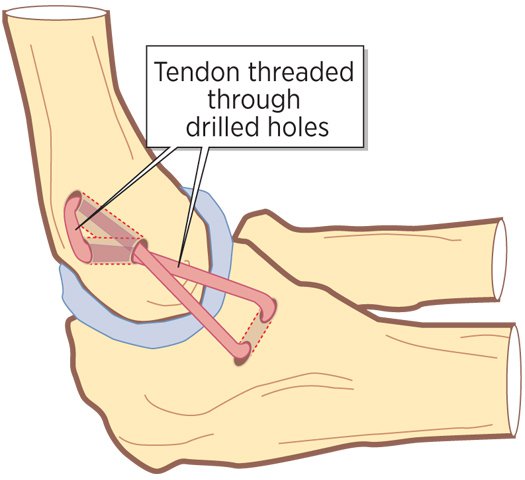Sports Injuries
Tommy John Surgery
Tommy John surgery repairs an injured elbow ligament. It’s most commonly done on college and pro athletes, especially baseball pitchers. But it’s sometimes done on younger people as well.
The surgery is named after former Los Angeles Dodgers pitcher Tommy John. In 1974, he underwent the first surgery of this type.
Tommy John surgery is also called UCL reconstruction. UCL is short for ulnar collateral ligament.
During Tommy John surgery, a surgeon replaces the injured UCL with a tendon taken from somewhere else in the patient’s body.
Other types of surgery for repairing the UCL have also been developed. Now, WebMD takes a look at the original Tommy John surgery that is still used today and has let thousands of athletes return to their previous level of play.
How UCL Injuries Develop
The UCL is located on the inside of the elbow. It connects the bone of the upper arm (humerus) to a bone in the forearm (ulna).
Anyone can get a UCL injury from repetitive stress to the elbow or from trauma. But throwers have the highest risk. That’s because throwing motions that twist and bend the elbow put extreme stress on the ligament.
Over time, the UCL can develop tiny or large tears. The ligament stretches and lengthens to the point where it can’t hold the bones tightly enough during throwing activities.
Most UCL injuries occur in baseball players. But other sports are sometimes linked to UCL injuries. These sports include:
- javelin throw
- tennis
- gymnastics
- soccer
- softball
- football
- wrestling
- cheerleading
Symptoms of a UCL Injury
Symptoms associated with a UCL injury include:
- Pain on the inside of the elbow
- A sense of looseness or instability in the elbow
- Irritation of the “funny bone” (ulnar nerve): This is felt as tingling or numbness in the small finger and ring finger.
- Decreased ability to throw a baseball or other object
Only rarely do UCL injuries interfere with non-throwing activities, such as:
- activities of daily living
- exercising
- lifting weights
- batting in baseball
- running
Diagnosis of UCL Injuries
Sometimes, a doctor can diagnose a UCL injury through just a history and physical examination. Diagnostic tests may include:
- X-rays
- MRI
- MRI after gadolinium dye has been injected into the elbow
Because such tests are not 100% accurate, however, it can be difficult to diagnose a UCL injury.
Candidates for Tommy John Surgery
UCL injuries are usually first treated with conservative (non-surgical) therapies. These therapies include:
- rest
- ice
- nonsteroidal anti-inflammatory drugs (NSAIDs)
Patients then typically undergo physical therapy. This strengthens surrounding muscles to compensate for the injured UCL.
But some athletes may be candidates to have surgery right away. Tommy John surgery is most commonly recommended for athletes who:
- Don’t respond to non-surgical treatments
- Want to resume strenuous overhead or throwing activities
What Happens During Tommy John Surgery
During Tommy John surgery, a tendon is taken from someplace in the patient’s body, such as his or her:
- wrist
- forearm
- toe
- hamstring (thigh)
- hip
- knee
- foot (Achilles tendon)
Sometimes, surgeons use a tendon donated from the body of someone who has died.
Surgeons drill tunnels in the ulna and humerus. The tendon (called a “graft”) is passed through the tunnels. It is then woven into a figure-eight pattern to reconstruct the ligament.
To give the graft added strength, any remnants of the original ligament are attached to the tendon.
Complications can occur in anywhere from 5% to 20% of patients, depending on the technique that is used. The most common complication is damage to the ulnar nerve.
Other complications can include infection or hematoma. Rarely, a complication will require additional surgery.
Tommy John Surgery Rehabilitation
Rehabilitation from Tommy John surgery usually takes about a year. In some cases, up to 2 years are needed for athletes to return to their previous level of ability. Other types of UCL surgery may not need this much rehabilitation.
Rehabilitation should be closely monitored by the patient’s doctor and physical therapist. Some rehabilitation programs follow a three-phase process:
Phase I. After surgery, patients take these steps:
- Wear a splint for 7 to 10 days to immobilize the elbow.
- Do gentle range-of-motion exercises for the wrist, hand, and shoulder.
- Wear a range-of-motion brace to gradually regain full motion of the elbow joint.
- Do exercises to strengthen the arm and shoulder.
- Perform total-body conditioning exercises.
Phase II. Starting about 6 weeks after surgery:
- Most patients can begin to perform elbow-strengthening exercises.
- For at least the next 4 months, most patients are advised to avoid activities that overstress the graft.
Phase III. In the final phase of rehabilitation, patients typically take these steps with their surgeon’s approval:
- About 4 or 5 months after surgery, athletes may toss a ball without a wind-up motion.
- After 6 months, athletes may start to use an easy wind-up when throwing.
- After 7 months, baseball pitchers may return to the mound.
- After 9 months, pitchers may throw in competition if they are pain-free and have regained their normal strength and range of motion.
When surgeon Frank Jobe, MD, performed the first UCL reconstruction on Tommy John in 1974, a torn UCL tear was considered to be a game-ending injury for most players.
But now, up to 85% of patients who undergo this surgery are able to resume their sport at, or even above, their previous level of competition.

